
Am Fam Physician. 2013;87(10):691-696
A more recent article on sinus node dysfunction is available.
Patient information: A handout on this topic is available at https://familydoctor.org/online/famdocen/home/common/heartdisease/basics/767.html.
Author disclosure: No relevant financial affiliations.
Sick sinus syndrome refers to a collection of disorders marked by the heart's inability to perform its pacemaking function. Predominantly affecting older adults, sick sinus syndrome comprises various arrhythmias, including bradyarrhythmias with or without accompanying tachyarrhythmias. At least 50 percent of patients with sick sinus syndrome develop alternating bradycardia and tachycardia, also known as tachybrady syndrome. Sick sinus syndrome results from intrinsic causes, or may be exacerbated or mimicked by extrinsic factors. Intrinsic causes include degenerative fibrosis, ion channel dysfunction, and remodeling of the sinoatrial node. Extrinsic factors can be pharmacologic, metabolic, or autonomic. Signs and symptoms are often subtle early on and become more obvious as the disease progresses. They are commonly related to end-organ hypoperfusion. Cerebral hypoperfusion is most common, with syncope or near-fainting occurring in about one-half of patients. Diagnosis may be challenging, and is ultimately made by electrocardiographic identification of the arrhythmia in conjunction with the presence of symptoms. If electrocardiography does not yield a diagnosis, inpatient telemetry monitoring, outpatient Holter monitoring, event monitoring, or loop monitoring may be used. Electrophysiologic studies also may be used but are not routinely needed. Treatment of sick sinus syndrome includes removing extrinsic factors, when possible, and pacemaker placement. Pacemakers do not reduce mortality, but they can decrease symptoms and improve quality of life.
Sick sinus syndrome is a collection of disorders defined by abnormal cardiac impulse formation and by abnormal propagation from the sinoatrial node, which prevents it from performing its pacemaking function. This condition, also known as sinus node dysfunction, is associated with an atrial rate that does not meet the body's physiologic requirements. It manifests clinically as arrhythmias that can include sinus bradycardia, sinus pauses or arrest, sinoatrial exit block, or alternating bradyarrhythmias and tachyarrhythmias. These manifestations can lead to chronotropic incompetence, which is an inadequate heart rate response to exercise or stress.1–6
| Clinical recommendation | Evidence rating | References |
|---|---|---|
| The diagnosis of sick sinus syndrome requires correlating symptoms of end-organ hypoperfusion with the presence of bradyarrhythmia observed on cardiac monitoring. If short-term monitoring is nondiagnostic, prolonged cardiac monitoring should be considered. | C | 3, 31–34 |
| Permanent pacemaker placement is recommended only in patients with symptomatic sick sinus syndrome and documented bradycardia. Pacemaker placement is considered the only effective treatment for chronic symptomatic sick sinus syndrome not caused by correctable extrinsic factors. | C | 1, 3, 6, 25 |
| When recommending pacemaker therapy to patients with sick sinus syndrome, physicians should explain that the goal is to relieve symptoms and improve overall quality of life. Pacemaker therapy has not been shown to affect survival in patients with sick sinus syndrome. | C | 43 |
Prevalence
Causes
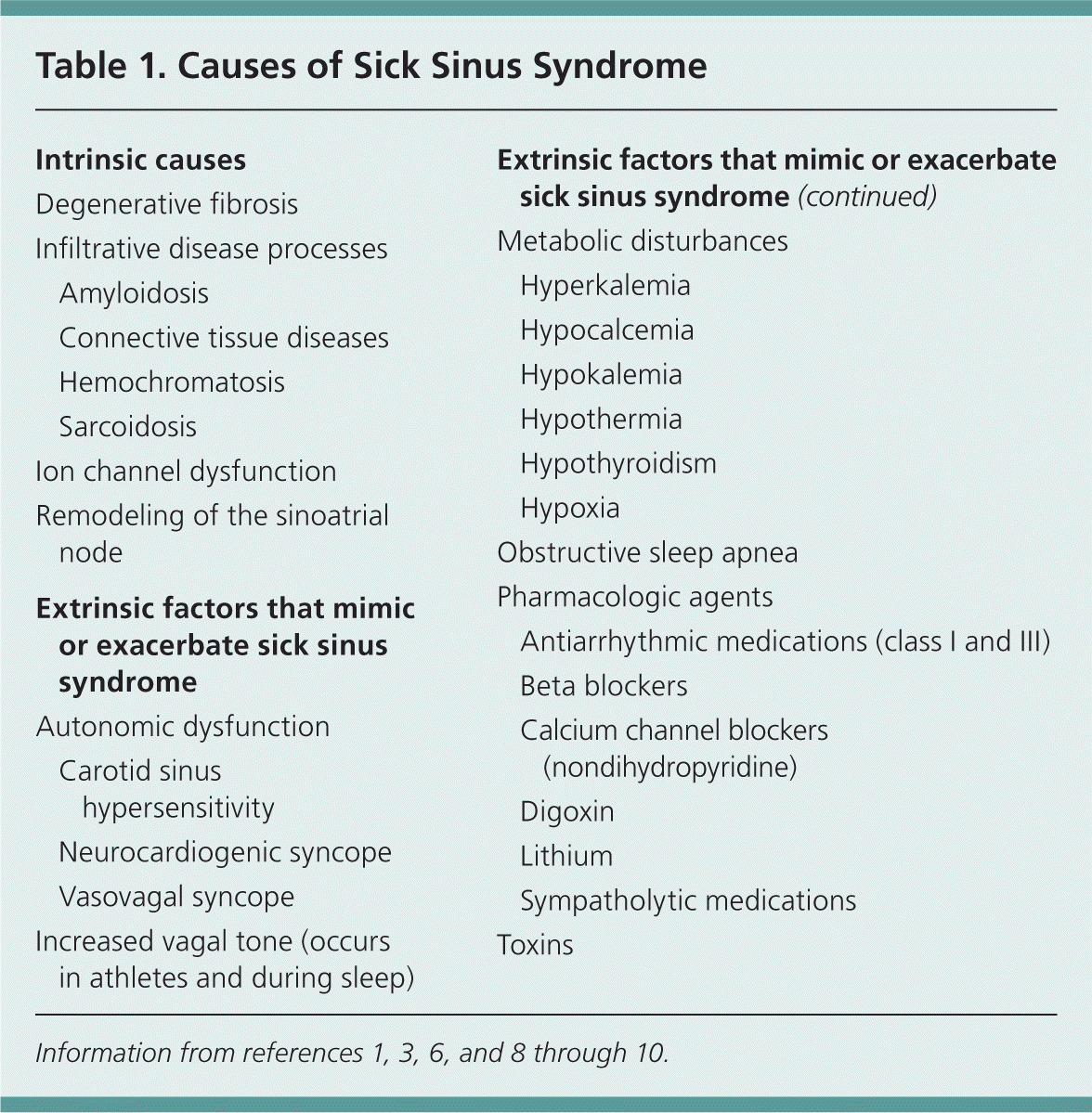
| Intrinsic causes | |
| Degenerative fibrosis | |
| Infiltrative disease processes | |
| Amyloidosis | |
| Connective tissue diseases | |
| Hemochromatosis | |
| Sarcoidosis | |
| Ion channel dysfunction | |
| Remodeling of the sinoatrial node | |
| Extrinsic factors that mimic or exacerbate sick sinus syndrome | |
| Autonomic dysfunction | |
| Carotid sinus hypersensitivity | |
| Neurocardiogenic syncope | |
| Vasovagal syncope | |
| Increased vagal tone (occurs in athletes and during sleep) | |
| Metabolic disturbances | |
| Hyperkalemia | |
| Hypocalcemia | |
| Hypokalemia | |
| Hypothermia | |
| Hypothyroidism | |
| Hypoxia | |
| Obstructive sleep apnea | |
| Pharmacologic agents | |
| Antiarrhythmic medications (class I and III) | |
| Beta blockers | |
| Calcium channel blockers (nondihydropyridine) | |
| Digoxin | |
| Lithium | |
| Sympatholytic medications | |
| Toxins | |
INTRINSIC CAUSES
Intrinsic causes of sick sinus syndrome include degenerative fibrosis of the sinoatrial node, ion channel dysfunction, and remodeling of the sinoatrial node. Historically, the most common intrinsic cause is thought to be age-related, idiopathic degenerative fibrosis of the sinoatrial node.8 Recent research and understanding of familial and congenital sick sinus syndromes, however, have shown that an inherited dysfunction of ion channels within the sinoatrial node also plays a significant part in age-related sick sinus syndrome.1,9,11–13
Remodeling of the sinoatrial node occurs in heart failure and atrial fibrillation, and this appears to play a role in the development of sick sinus syndrome for some patients.1,14,15 Certain infiltrative disease processes, including connective tissue diseases, hemochromatosis, sarcoidosis, and amyloidosis, may also cause intrinsic dysfunction of the sinoatrial node.10 Atherosclerotic changes of the sinus node artery, which originates from the proximal right coronary artery in 65 percent of patients,10 may contribute to chronic ischemia and subsequent fibrosis of the sinoatrial node, but are not considered to be a major cause of sick sinus syndrome.3,16
EXTRINSIC FACTORS
Extrinsic factors that can mimic or exacerbate sick sinus syndrome include the use of certain pharmacologic agents, metabolic disturbances, and autonomic dysfunction. The pharmacologic agents that commonly cause dysfunction of the sinoatrial node are beta blockers, calcium channel blockers, digoxin, sympatholytic medications, antiarrhythmic medications, and lithium.10,17 The most common electrolyte abnormalities leading to dysfunction of the sinoatrial node are hyperkalemia, hypokalemia, and hypocalcemia.
Other extrinsic factors include hypothyroidism, hypoxia, hypothermia, and toxins. Autonomic dysfunction can mimic or exacerbate sick sinus syndrome via neurally mediated bradycardia in vasovagal syncope, neurocardiogenic syncope, and carotid sinus hypersensitivity.10,18–20 Although rare, findings of sick sinus syndrome can be associated with other cardiac abnormalities such as Brugada syndrome, which is an ion channel disorder that can lead to sudden cardiac death.5,21
Signs and Symptoms
Sick sinus syndrome tends to be progressive. Patients often are asymptomatic early in the disease course, whereas those with more advanced disease can present with symptoms and signs of end-organ hypoperfusion. Cerebral hypoperfusion is the most common, and approximately 50 percent of patients with sick sinus syndrome have near-fainting spells or syncope.3,4,22 End-organ hypoperfusion can also manifest as transient lightheadedness, confusion, fatigue, palpitations, angina, congestive heart failure, stroke, transient ischemic attacks, vague gastrointestinal symptoms, or oliguria.3,4,22,23
Electrocardiographic Findings
The diagnosis of sick sinus syndrome requires electrocardiographic findings of bradyarrhythmias, such as sinus bradycardia, sinoatrial pause of three seconds or more, sinoatrial exit block, or sinus arrest1–6 (Table 23,24 ). However, findings often are normal in patients with sick sinus syndrome, particularly early in the disease course, making the diagnosis a challenge.
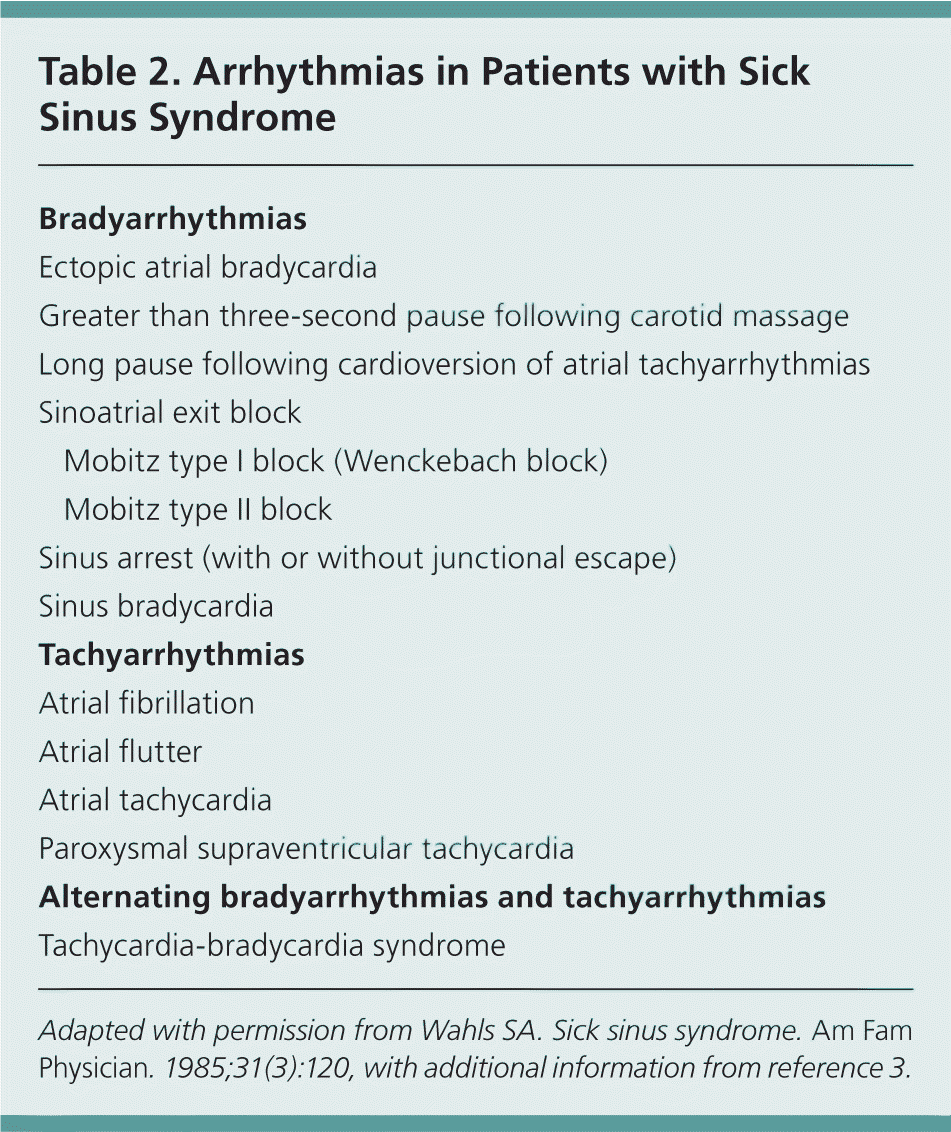
| Bradyarrhythmias | |
| Ectopic atrial bradycardia | |
| Greater than three-second pause following carotid massage | |
| Long pause following cardioversion of atrial tachyarrhythmias | |
| Sinoatrial exit block | |
| Mobitz type I block (Wenckebach block) | |
| Mobitz type II block | |
| Sinus arrest (with or without junctional escape) | |
| Sinus bradycardia | |
| Tachyarrhythmias | |
| Atrial fibrillation | |
| Atrial flutter | |
| Atrial tachycardia | |
| Paroxysmal supraventricular tachycardia | |
| Alternating bradyarrhythmias and tachyarrhythmias | |
| Tachycardia-bradycardia syndrome | |
Although bradyarrhythmias are required for the diagnosis, supraventricular tachyarrhythmias are present in at least 50 percent of patients with sick sinus syndrome.6,25 Episodes of alternating tachyarrhythmias and bradyarrhythmias are known as tachycardiabradycardia, or tachybrady, syndrome1,3,6,25 (Figure 13 ).
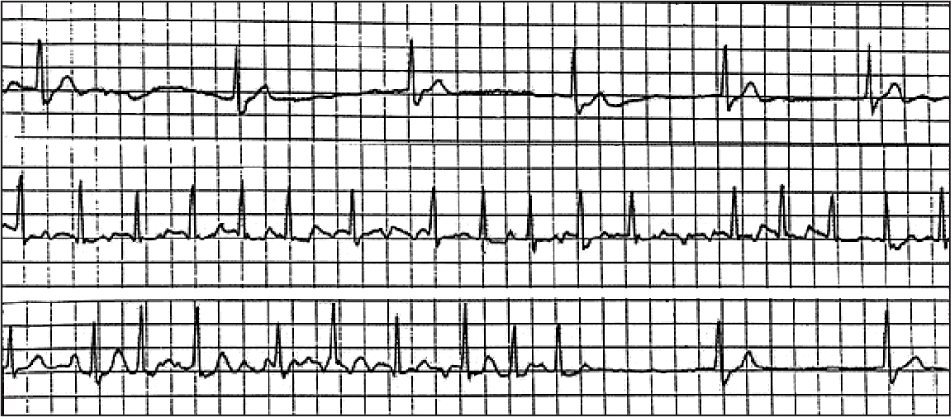
The most common tachyarrhythmias are atrial fibrillation or flutter with rapid ventricular response.5,6 These tachyarrhythmias are more common in older patients with advanced sinoatrial nodal disease in whom sinoatrial node fibrosis may favor reentrant beats or tachycardia.8,26 Additionally, there is evidence that atrial fibrillation and flutter can lead to atrial remodeling and subsequent dysfunction of the sinoatrial node.1,14,15
Clinical Diagnosis
Sick sinus syndrome is diagnosed by correlating symptoms of end-organ hypoperfusion with the occurrence of bradycardia, with or without accompanying tachycardia.3 Electrocardiographic abnormalities and clinical symptoms must be present. Marked bradycardia, including sinoatrial pauses of three seconds or more, is not diagnostic of sick sinus syndrome in the absence of symptoms. Electrocardiographic abnormalities in the absence of symptoms may be explained by physiologic and pathophysiologic processes such as increased vagal tone during sleep or obstructive sleep apnea.6,27,28
When 12-lead electrocardiography does not yield a diagnosis, prolonged cardiac monitoring should be considered.5,29 Depending on the severity of symptoms and the overall clinical picture, this can be done in the hospital via telemetry monitoring or on an outpatient basis with a 24- to 48-hour Holter monitor.30 If no definitive diagnosis is made, Holter monitoring can be repeated. If clinical suspicion of arrhythmia remains high and Holter monitoring results are negative, the next step should be longer-duration cardiac monitoring.31–33 Monitoring can occur for weeks at a time with external continuous or event monitors, or for months at a time with an implantable loop recorder; Table 3 lists available ambulatory monitoring devices.30,34,35
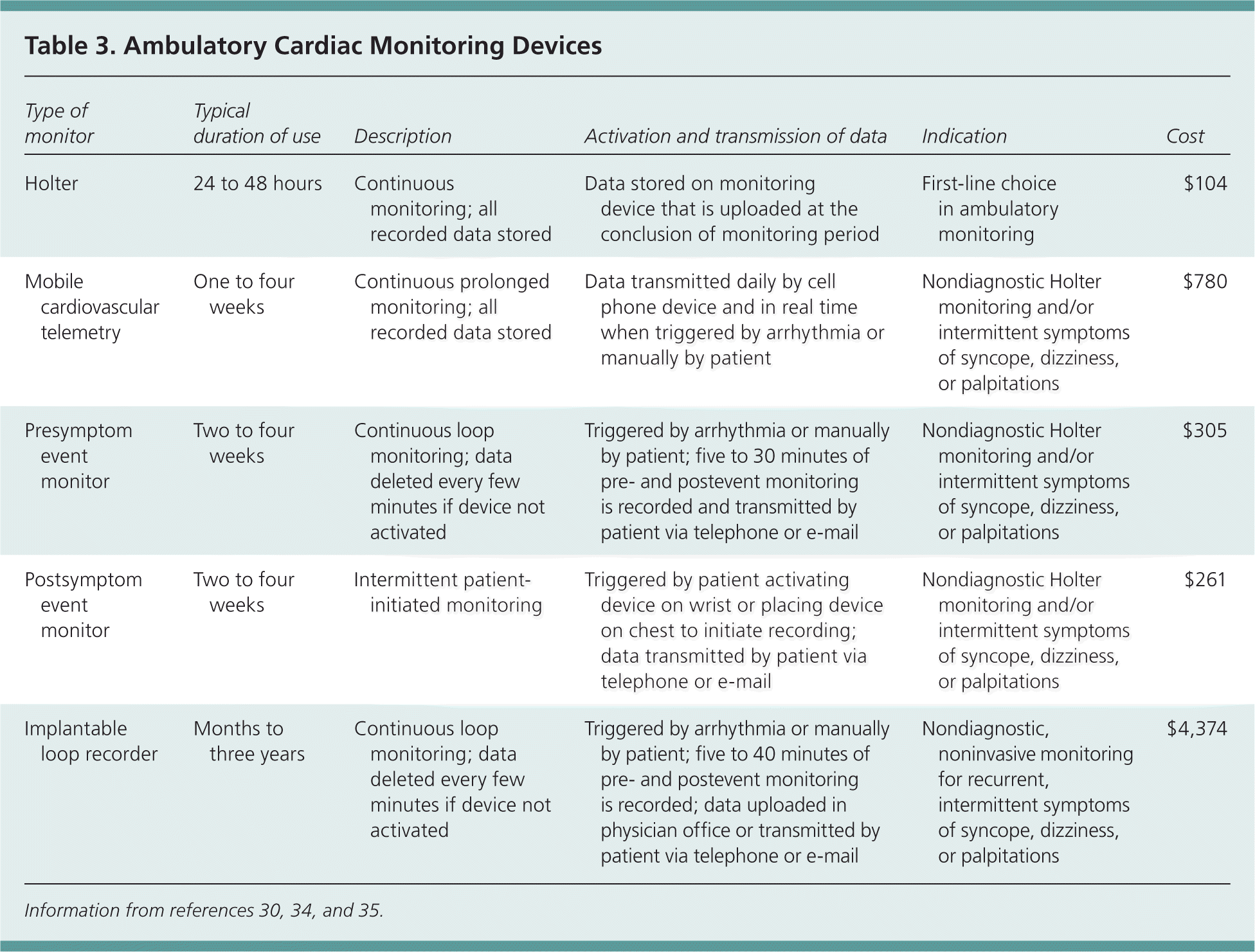
| Type of monitor | Typical duration of use | Description | Activation and transmission of data | Indication | Cost |
|---|---|---|---|---|---|
| Holter | 24 to 48 hours | Continuous monitoring; all recorded data stored | Data stored on monitoring device that is uploaded at the conclusion of monitoring period | First-line choice in ambulatory monitoring | $104 |
| Mobile cardiovascular telemetry | One to four weeks | Continuous prolonged monitoring; all recorded data stored | Data transmitted daily by cell phone device and in real time when triggered by arrhythmia or manually by patient | Nondiagnostic Holter monitoring and/or intermittent symptoms of syncope, dizziness, or palpitations | $780 |
| Presymptom event monitor | Two to four weeks | Continuous loop monitoring; data deleted every few minutes if device not activated | Triggered by arrhythmia or manually by patient; five to 30 minutes of pre- and postevent monitoring is recorded and transmitted by patient via telephone or e-mail | Nondiagnostic Holter monitoring and/or intermittent symptoms of syncope, dizziness, or palpitations | $305 |
| Postsymptom event monitor | Two to four weeks | Intermittent patient-initiated monitoring | Triggered by patient activating device on wrist or placing device on chest to initiate recording; data transmitted by patient via telephone or e-mail | Nondiagnostic Holter monitoring and/or intermittent symptoms of syncope, dizziness, or palpitations | $261 |
| Implantable loop recorder | Months to three years | Continuous loop monitoring; data deleted every few minutes if device not activated | Triggered by arrhythmia or manually by patient; five to 40 minutes of pre- and postevent monitoring is recorded; data uploaded in physician office or transmitted by patient via telephone or e-mail | Nondiagnostic, noninvasive monitoring for recurrent, intermittent symptoms of syncope, dizziness, or palpitations | $4,374 |
Although rhythm monitoring is the diagnostic standard, electrophysiologic studies are sometimes useful in the evaluation of sick sinus syndrome. These studies evaluate patients in whom sick sinus syndrome is strongly suspected but no arrhythmia has been demonstrated that correlates with symptoms after prolonged cardiac monitoring.7
The rhythm abnormalities of sick sinus syndrome occasionally are detected or suspected as an incidental finding during evaluation and treatment of other cardiac conditions.36 For example, two small studies of patients undergoing exercise treadmill testing found that 38 to 57 percent of patients with known sick sinus syndrome were unable to achieve a maximal heart rate of 120 beats per minute.37,38 This inadequate response to exercise suggests chronotropic incompetence that occurs in persons with sick sinus syndrome, but there are no well-validated standards for diagnosing sick sinus syndrome in this setting.6 Carotid sinus massage or pressure that results in a sinoatrial pause for more than three seconds is also suggestive, but not diagnostic, of sick sinus syndrome.3,5,18
Complications of Sick Sinus Syndrome
More than 50 percent of patients with sick sinus syndrome develop tachy-brady syndrome with atrial fibrillation or flutter as the tachyarrhythmia, leading to an increased risk of embolic stroke. Anticoagulation therapy has been shown to decrease the number of embolic events and strokes, and the decision to start anticoagulant medication can be based on American College of Cardiology Foundation/American Heart Association guidelines.39
Treatment
Permanent pacemaker placement is recommended only in patients with symptomatic sick sinus syndrome and documented bradycardia6; it is the only effective treatment for chronic symptomatic sick sinus syndrome that is not caused by correctable extrinsic factors.1,3,25 In 2009, there were 235,567 new pacemakers implanted in the United States.42 Historically, sick sinus syndrome accounts for one-half of pacemaker implantations.1,3,25
Pacemaker therapy has not been shown to affect survival rates in this population. Rather, the primary goal of pacemaker placement is to relieve symptoms and improve quality of life.43 Tables 46 and 56,44–50 list indications for pacemaker implantation in patients with sick sinus syndrome. Given the propensity for these patients to develop atrioventricular block, dual-chamber pacemakers are generally preferred.6,44–50
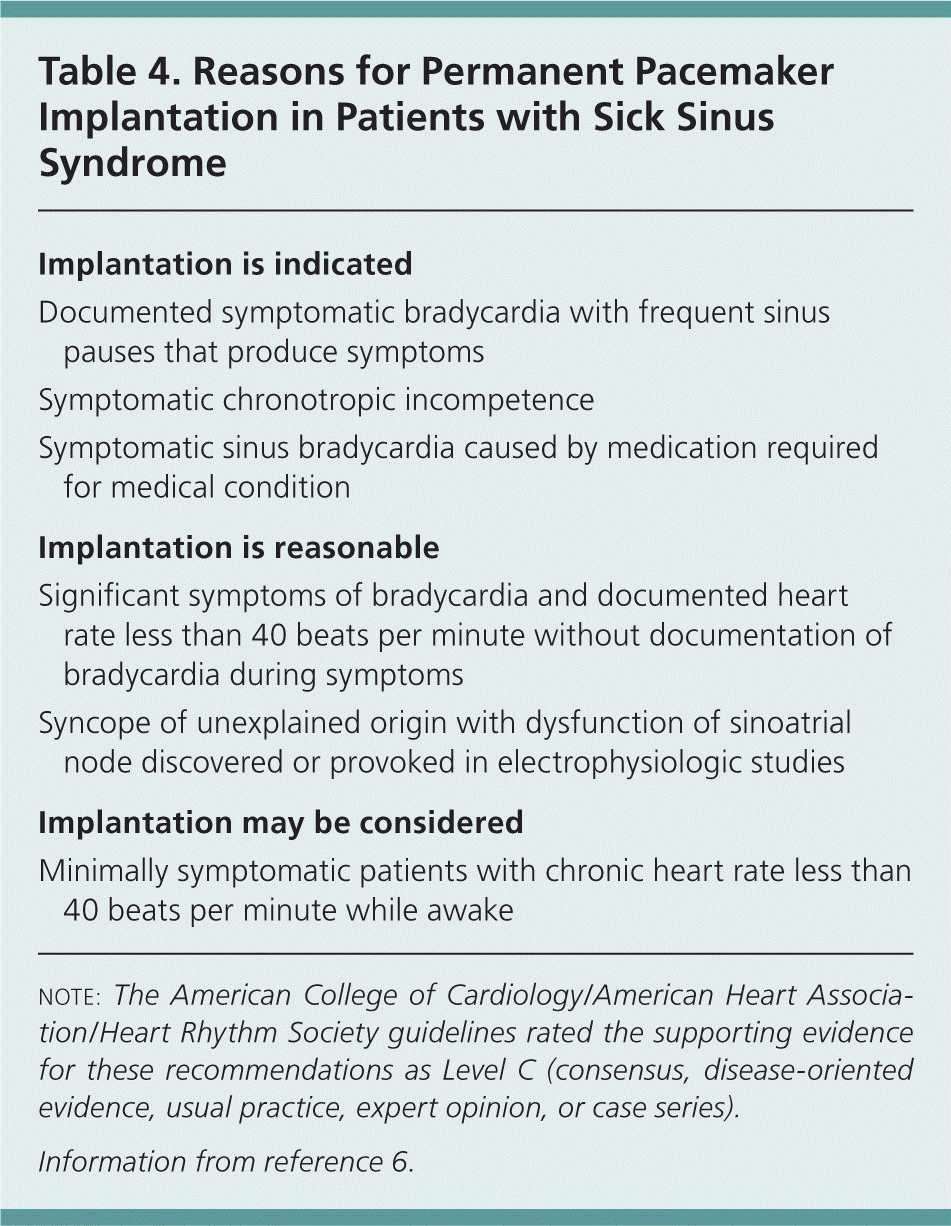
| Implantation is indicated |
| Documented symptomatic bradycardia with frequent sinus pauses that produce symptoms |
| Symptomatic chronotropic incompetence |
| Symptomatic sinus bradycardia caused by medication required for medical condition |
| Implantation is reasonable |
| Significant symptoms of bradycardia and documented heart rate less than 40 beats per minute without documentation of bradycardia during symptoms |
| Syncope of unexplained origin with dysfunction of sinoatrial node discovered or provoked in electrophysiologic studies |
| Implantation may be considered |
| Minimally symptomatic patients with chronic heart rate less than 40 beats per minute while awake |
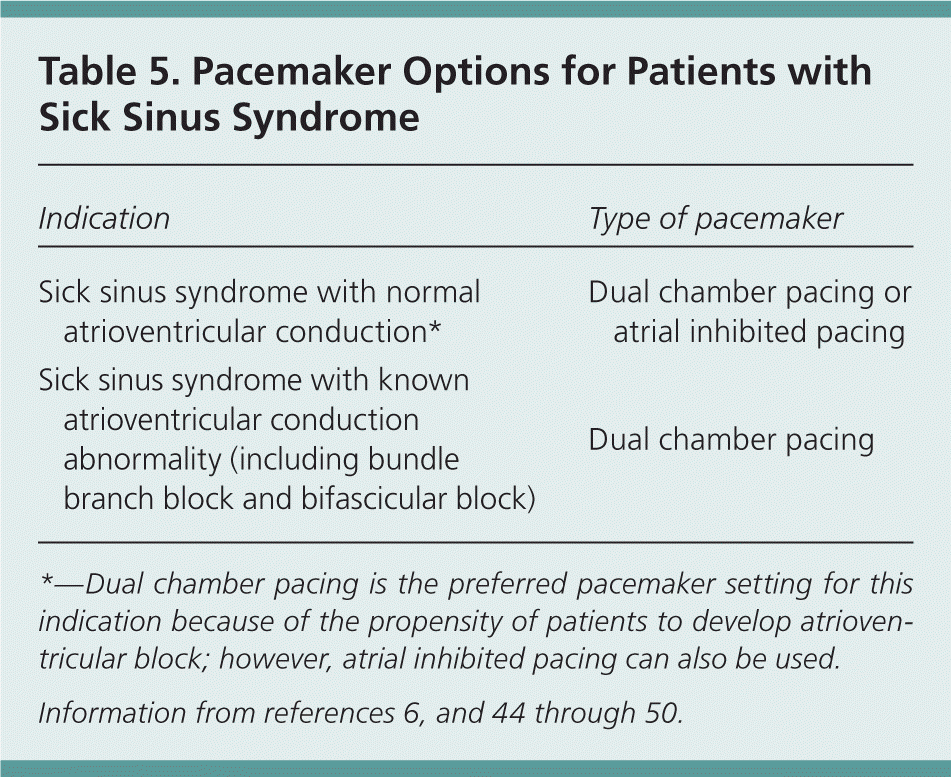
| Indication | Type of pacemaker |
|---|---|
| Sick sinus syndrome with normal atrioventricular conduction* | Dual chamber pacing or atrial inhibited pacing |
| Sick sinus syndrome with known atrioventricular conduction abnormality (including bundle branch block and bifascicular block) | Dual chamber pacing |
Data Sources: A PubMed search was performed using the key terms sick sinus syndrome, sinus node dysfunction, and tachy-brady syndrome. The search included randomized controlled trials, reviews, clinical trials, and meta-analyses. A search was also done using Essential Evidence Plus, the Cochrane Database of Systematic Reviews, the Agency for Healthcare Research and Quality evidence reports, the National Guideline Clearinghouse, DynaMed, and UpToDate. Search date: January 16, 2012.
